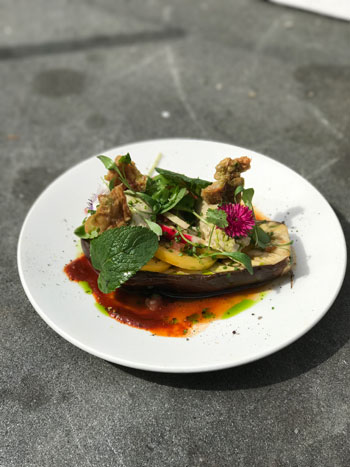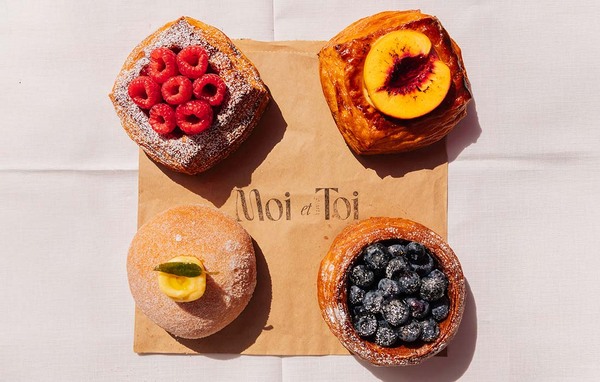Flexitarianism : what impact will this have on your menu?
The Sustainable Restaurant Association is calling on chefs to serve more veg and better meat, not only for our health and that of the planet, but also because of mushrooming customer demand. Elly Earls looks at the growth of flexitarianism and its impact on modern menus
Nearly half of Brits now identify as flexitarian. Only 18% believe meat is necessary for a good meal, and 44% are willing or already committed to cutting down on or eliminating animal-based products from their diets. So across the country, an increasing number of chefs are challenging themselves to get creative with the panoply of plant-based products at their disposal. And during the month of August, the Sustainable Restaurant Association (SRA) is calling on the whole foodservice sector to join them. The SRAâs Serve More Veg and Better Meat campaign is emphasising that chefs really do have the power to change behaviour. With livestock production accounting for 15% of global carbon emissions, they canât get started soon enough.
Making veggies sexy
Thatâs not to say itâs going to be easy. Although UK consumers are making a clear move away from meat, they donât want to feel like theyâre being short-changed or for dishes to be any less exciting.
Sam Clarke, owner of London-based Moroccan restaurant Moro, admits it is that little bit more difficult to make a dish appealing and appetising when youâve got only vegetables to play with. âYou have to work a bit harder to cook vegetarian food â" you have to be committed to making the vegetarian options more sexy and enticing,â he says. âPeople need to feel really spoilt and enticed to have that vegetarian option. You need to gently give them an offer they canât refuse, which does mean you have to be a bit more generous of spirit when it comes to time.â
More and more chefs are rising to the challenge. For example, farm-to-table restaurant the Shed in Londonâs Notting Hill, which opened in 2012, offers as many plant-based options as it does meat and fish dishes â" and itâs the veggie options that are the stars.

Gladwin loves to forage, which, he says, adds an extra dimension of flavour, nutrition and excitement to the menu. He also works hard to capture umami flavours.
âSomething like braised fennel is a really good example,â he says. âI love combining two ingredients to create something special â" transmodification I call it â" like tomato and geranium. Having these marriages of flavour up your sleeve makes a real difference.â
Diners, he adds, will often order the Shedâs veggie dishes over their meaty counterparts because they genuinely prefer the sound of the dish. Since small-plates restaurant Root opened in Bristol earlier this year, itâs been a similar
story. âThe meat and the fish are the least popular things,â says head chef Rob Howell, who has relished the challenge of coming up with veggie dishes that are so good that customers donât register theyâre not eating meat.
âWeâve got a cauliflower dish that people love. Itâs a cross-section of the cauliflower accompanied by a salad made from all the trimmings, with a little bit of lemon, rapeseed oil and salt. Iâve made a purée with the rest of the trimmings and I serve it with a bit of cashew milk. Nothing is wasted, itâs completely vegan and itâs delicious.â
Chefs neednât worry either that serving more veg means compromising in the protein department. âThe obvious ones are tofu, tempeh, Quorn and textured vegetable proteins; the least obvious are pulses and grains, such as quinoa, chickpeas, turtle beans, kidney beans, millet and buckwheat,â says Duncan Parsonage, head of food development at freshfoods supplier Fresh Direct. âPeas, broccoli and the dreaded Brussels sprouts also punch well above their weight in the protein stakes.â
Mixing up the menu
Simple nudging techniques can also go a long way towards encouraging diners to pick a veg option over a meat one, as Clark has learned. Following a dinner he attended in the spring, which was hosted by the SRA at Fifteen to get chefs thinking about what they can do to encourage their customers to eat more veg, he moved the mixed vegetable mezze to the top of the list of main courses. Ever since, sales of the dish have risen by an average of 25%.
At Root the menu features 10 veg-based dishes accompanied by five meat and fish dishes, while at the Shed the six veg dishes are listed before the one offal, three fish and three meat dishes. Gladwin is also in the process of introducing vegetarian dishes that will come with an option of ordering additional meat.
âEssentially, we are turning the menu on its head and trying to change the traditional pattern of meat being the main part of the meal and veg just a boring side dish,â he says.
Small changes, big difference
Crucially, the SRA isnât saying restaurants need to eliminate all meat â"just a small reduction can make a big difference. In fact, if everyone in the world went meat- free one day a week, weâd reduce our carbon emissions by 2%. The less is more philosophy is the same one that IntoFood founder Will Nicholson is using to help his restaurant and contract catering clients in Norway understand. He explains: âOur software integrates with companiesâ recipe management and procurement systems to help them understand the environmental impact of the food theyâre using. For example, if they reduce the amount of pork in a casserole from 120g to 80g, theyâll cut their carbon emissions by 20%-25% and their food costs by around 10%.â
In theory, this can then be invested into buying better-quality, more sustainable meat, something Olivia Gautier, patron of former International Sustainable Restaurant of the Year Les Orangeries in France, is adamant about. âIf you put less meat and less fish on the menu, you have to have the best meat and fish possible,â she stresses. âItâs crucial to underline all the effort youâre putting into sourcing high-standard products so people know youâre not just making profit off their backs.â
At Les Orangeries, Gautier and chef David Royer have just launched a new menu pitched midway between their regular and vegetarian menus, made up of 70% veg and 30% meat or fish. They also share the precise calculations of the environmental impact of their menu with their guests, thanks to an eco- calculator developed by the eco2 initiative in France.
âIt is striking to discover how the impacts change depending on the ingredients on the plate and their proportions,â Gautier says.
At present Nicholson is working with FD Hospitality to bring his IntoFood sustainability measurement system to clients in the UK via an integration with FDâs catering management software, Saffron. FD hopes to have a pilot up and running within three to six months and ultimately aims to make the carbon footprints of recipes available to clients and to the public, giving diners the power to purchase dishes based on their environmental impact.
Whether people are moving away from meat for health reasons or to do their bit for the planet, flexitarianism is here to stay. The only question is whether operators will follow the lead of the chefs who have definitively proven that moving meat down the menu doesnât mean making it any less exciting.
âWe need to get people to stop thinking about the protein and start thinking about the dishes they love,â Clark concludes. âItâs a wonderful challenge for chefs.â
Ramping up the intensity at River Cottage HQ
For Gelf Anderson, head chef at River Cottage HQ, one of the ways to get people to eat more plant-based dishes is to not make a big song and dance about them being vegetarian or vegan.
âWe do a four-course dinner and meat only appears on one dish,â he says. âBy treating the dish with the same love and care as the meat dishes and making them sound delicious, people will lap them up. To me, chermoula carrots and labneh sounds so much more interesting than a simple hanger steak.â
Flavour is also really important, particularly for meat eaters who have the veggie option. âIâve been doing a lot of smoked onions this year, smoking them over oak chips â" they provide a really meaty flavour,â Anderson says.
He adds that when meat is included in a dish, he always tries to make sure the flavour is so intense that the diner is blown away by only a small amount. âI think we can change the mind-set of those people who just expect a slab of meat. Our sticky beef, for instance, is braised for 24 hours in stock and then broken into chunks and painted with golden syrup, glucose, stock and aromatics. It has such an intense flavour that even the most carnivorous are satisfied after a few mouthfuls.â
For more information about the SRAâs campaign, go to www.foodmadegood.org




















